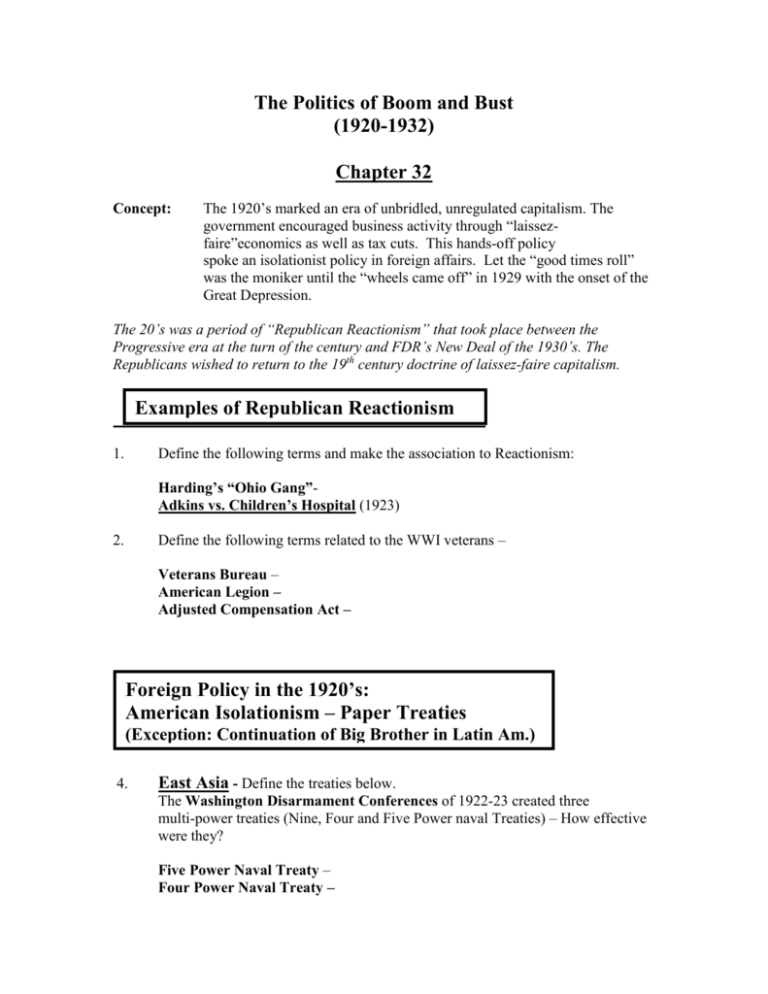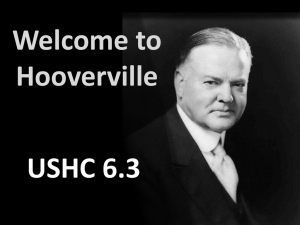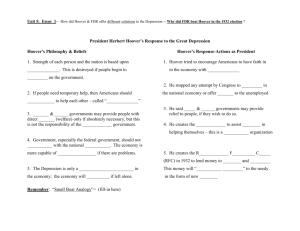Chapter 32
advertisement

The Politics of Boom and Bust (1920-1932) Chapter 32 Concept: The 1920’s marked an era of unbridled, unregulated capitalism. The government encouraged business activity through “laissezfaire”economics as well as tax cuts. This hands-off policy spoke an isolationist policy in foreign affairs. Let the “good times roll” was the moniker until the “wheels came off” in 1929 with the onset of the Great Depression. The 20’s was a period of “Republican Reactionism” that took place between the Progressive era at the turn of the century and FDR’s New Deal of the 1930’s. The Republicans wished to return to the 19th century doctrine of laissez-faire capitalism. Examples of Republican Reactionism 1. Define the following terms and make the association to Reactionism: Harding’s “Ohio Gang”Adkins vs. Children’s Hospital (1923) Define the following terms related to the WWI veterans – 2. Veterans Bureau – American Legion – Adjusted Compensation Act – Foreign Policy in the 1920’s: American Isolationism – Paper Treaties (Exception: Continuation of Big Brother in Latin Am.) 4. East Asia - Define the treaties below. The Washington Disarmament Conferences of 1922-23 created three multi-power treaties (Nine, Four and Five Power naval Treaties) – How effective were they? Five Power Naval Treaty – Four Power Naval Treaty – Nine Power Treaty – Kellogg-Briand Pact - 5. Caribbean – (Use pp. 755-756 to answer.) This area is the exception to isolationism, for the US continues its “Big Brother Policy”. - Describe US actions in Haiti and Nicaragua – What was the issue in Mexico and how was it resolved? – What was the reaction of Latin Americans? – 6. - European Debt and Reparations Payments Cycle (Use p. 756-757) - Define the Dawes Act of 1924. What was the European reasoning as to why they shouldn’t have to pay back the debt? – What was the Hoover Debt Moratorium of 1931? And how did the episode end? How did the whole sordid episode influence the course of events in the 1930’s? - 7. Explain what the European debt was from and what the reparations were for Tariffs – How high was the Fordney-McCumber Tariff of 1922? What was the effect of this tariff on international market? Harding Scandals – The Second Era of Good Stealings 8. Define the scandals listed below that destroyed Harding’s Administration: Forbes’ Veteran Bureau Scandal – Teapot Dome Scandal – (1921) –. Investigation of Attorney General Daugherty – Coolidge Administration – 1923-1929 9. After reading p. 753, characterize his personal attributes and his philosophy on how to run the country. Also, what was the “mentality” of American society during his administration. 10. Interpret the meaning of Coolidge’s quote – “The man who builds a factory builds a temple.” 11. Farmers: What obstacles did farmers face in the 1920’s? Define : Capper-Volstead Act – How effective were these bills in giving relief to the farmers? Hoover’s Administration (1929-1933) 12. Election of 1932: Al Smith “The Happy Warrior” (Democrats) – what were his handicaps? Herbert Hoover – (Republican) what were his attributes and what was his message? 13. Hawley-Smoot Tariff (1930) – Define its provisions and explain how it impacted world trade and politics. The Great Depression – The Start: (1929-1932) 14. Stock Market Crash: What happened on “Black Tuesday”? – What triggered the crash initially? 15. Characterize the depth of the depression by 1932 – 16. What were the causes of the Great Depression? 17. What were “Hoovervilles”? 18. Why didn’t Hoover want to use federal government money to “bail out” the people and provide jobs (in the first 3 years)? 19. Though mostly unfair, what did critics say about Hoover? 20. Hoover belatedly switches to mild governmental intervention. Define these programs – Hoover Dam – Reconstruction Finance Corporation (1932) – Norris-LaGuardia Anti-Injunction Act (1932)- 21. Why did Hoover veto the Muscle-Shoals Bill? 21. Though not very effective what was significant about the few programs started under Hoover? 23. Bonus Army – (1932) – What did they want and how did Hoover handle the situation? 24. Japan invades Manchuria – What occurred? 25. Hoover-Stimson Doctrine - define and explain its effectiveness. 26. Good Neighbor Policy (“foundation by Hoover, but built by Roosevelt”) what was this policy? Give two examples. What are the theme/themes of this chapter? Provide at least three specific examples of that theme(s). 27.








